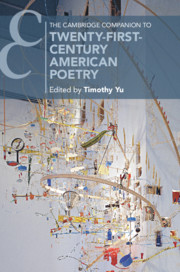Book contents
- The Cambridge Companion to Twenty-First-Century American Poetry
- The Cambridge Companion to Twenty-First-Century American Poetry
- Copyright page
- Contents
- Notes on Contributors
- Chronology
- Introduction
- 1 New Black Aesthetics: Post–Civil Rights African American Poetry
- 2 Traditions of Innovation in Asian American Poetry
- 3 Locations of Contemporary Latina/o Poetry
- 4 Sovereign Poetics and Possibilities in Indigenous Poetry
- 5 Changing Topographies, New Feminisms, and Women Poets
- 6 The Nearly Baroque in Contemporary Poetry
- 7 Disability Aesthetics and Poetic Practice
- 8 Queer Poetry and Bioethics
- 9 Trauma and the Avant-Garde
- 10 Blockade Chants and Cloud-Nets: Terminal Poetics of the Anthropocene
- 11 Give Me Poems and Give Me Death: On the End of Slam(?)
- 12 Anti-capitalist Poetry
- 13 Of Poetry and Permanent War in the Twenty-First-Century
- 14 Poetry in the Program Era
- 15 The Future of Poetry Studies
- Further Reading
- Index
- Cambridge Companions to …
- References
6 - The Nearly Baroque in Contemporary Poetry
Published online by Cambridge University Press: 25 February 2021
- The Cambridge Companion to Twenty-First-Century American Poetry
- The Cambridge Companion to Twenty-First-Century American Poetry
- Copyright page
- Contents
- Notes on Contributors
- Chronology
- Introduction
- 1 New Black Aesthetics: Post–Civil Rights African American Poetry
- 2 Traditions of Innovation in Asian American Poetry
- 3 Locations of Contemporary Latina/o Poetry
- 4 Sovereign Poetics and Possibilities in Indigenous Poetry
- 5 Changing Topographies, New Feminisms, and Women Poets
- 6 The Nearly Baroque in Contemporary Poetry
- 7 Disability Aesthetics and Poetic Practice
- 8 Queer Poetry and Bioethics
- 9 Trauma and the Avant-Garde
- 10 Blockade Chants and Cloud-Nets: Terminal Poetics of the Anthropocene
- 11 Give Me Poems and Give Me Death: On the End of Slam(?)
- 12 Anti-capitalist Poetry
- 13 Of Poetry and Permanent War in the Twenty-First-Century
- 14 Poetry in the Program Era
- 15 The Future of Poetry Studies
- Further Reading
- Index
- Cambridge Companions to …
- References
Summary
The twenty-first-century poets and poems of the nearly Baroque want art that puts excess, invention, and ornament first. Some poets, such as Angie Estes, Robyn Schiff, and Lucie Brock-Broido have pursued a nearly Baroque aesthetic for almost the whole of their careers. Other recent exemplars include Nada Gordon, Ange Mlinko, Kiki Petrosino, Geoffrey Nutter, and Brenda Shaughnessy. Nearly Baroque contemporary poems exhibit elaborate syntax, and self-consciously elaborate sonic patterning, without adopting pre-modernist forms. The nearly Baroque is a femme aesthetic and defends traditionally feminine ideas of beauty and extravagance against the insistence on practicality, on political utility, on conceptual novelty, or on efficiency. At the same time these poets tend to note – they may sound guilty about – the serious effort and energy devoted to making such complicated, luxurious, or apparently useless things as contemporary literary poems. The most recent poets to work in the nearly Baroque idiom take increasing account of the actual bodies and bodily histories that do not fit well with conventional standards of prettiness, ornament, femininity, or beauty. Poets of color who foreground race have sometimes chosen not so much exactly the strategies described here but related ones, ones that benefit from the comparison.
- Type
- Chapter
- Information
- Publisher: Cambridge University PressPrint publication year: 2021



